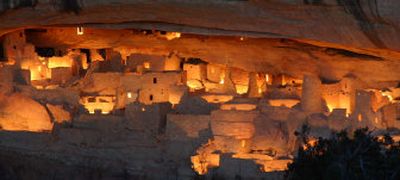Mesa Verde’s sand castles

MESA VERDE NATIONAL PARK, Colo. – Most national parks protect natural wonders – mountains, forests, canyons.
But Mesa Verde was the very first national park created to preserve man-made wonders – ancient cliff dwellings, made from sandstone, perched on ledges at elevations of 7,000 feet.
This intricate architecture, dating to the 12th century, is as awesome to behold today as it was when cowboys and ranchers first saw it. Two men looking for lost cattle, Richard Wetherill and Charles Mason, came upon the most spectacular site, the 150-room Cliff Palace, in 1888.
Mesa Verde National Park was established 18 years later, in 1906. The park’s centennial is being observed this year with festivals, lectures and access to sites that have been closed to the public for decades.
“It’s not just a birthday party to commemorate 100 years in June 2006,” said Tessy Shirakawa, chief of visitor services for the park. “It is a yearlong celebration about the last 100 years, and looking into the future to the next 100 years.”
A four-day party, free to the public, with a birthday cake, music, Indian dances, a traders’ festival, craft demonstrations and other events is scheduled for June 29 to July 2.
Other highlights of the centennial include monthly lectures and demonstrations; daylong horseback rides in September to Spring House, which has been closed since the 1960s; and ranger-led hikes to two other dwellings.
One of these, Mug House, has never been open to the public before, and another, Oak Tree House, has been closed since the 1930s.
The celebration ends Dec. 9 with a “luminaria” – nighttime illumination – of Cliff Palace and Spruce Tree House, another dwelling.
The cliff dwellings were built by a group of people whom archaeologists refer to as Ancestral Puebloans. They lived in the area from about 400 A.D. to 1300 A.D. Their descendants include 21 contemporary tribes.
“They were incredible masons,” said Ranger Kimberly Accardy on a tour of Cliff Palace, the largest of the park’s 600 dwellings. “They did not have metal. All their tools were made out of wood, stone or bone.”
Bricks for the buildings were made from sandstone mixed with mud mortar.
Accardy said Cliff Palace was probably “a community center for trade, commerce or special ceremonies. Only 125 people lived here, but many more people came here. It’s a bit like the idea of people living on the outskirts of a major metropolitan area and coming into the central area to take care of their needs.”
Cliff Palace’s 150 rooms include walls up to four stories high, nine storage rooms on an upper ledge, and 21 “kivas,” deep round pits used for ceremonies and other community activities. Kivas are still used by modern-day Hopis and other tribes.
The Puebloans hunted wild game, domesticated turkeys, and grew corn, squash and beans. For water, Accardy said, “they relied on rain and snow-melt, and a lot of the alcoves had seep springs” – water that trickled in through the canyon walls.
Most first-time visitors to Mesa Verde – which is Spanish for “green table” – tour Cliff Palace. But adventurous types – including sure-footed children – will also want to see Balcony House, which can only be accessed by climbing steep ladders and shimmying through an 18-inch-wide stone tunnel.
Balcony House is much smaller than Cliff Palace, but its highlights include interesting archaeological evidence. Shell prints on the sandstone suggest that millions of years ago, “this was the shore of an ancient sea,” according to Ranger Lee Littler.
Littler also pointed out red plaster on the walls, along with paintings of triangular designs that resemble mountain ridges.
“Everybody wants to add personal touches and beauty to their homes,” Accardy said.
The same year Mesa Verde was made a national park, Congress passed a law making it a crime to collect or destroy antiquities from federal land. The law was spurred in part by the removal of 600 objects from Mesa Verde by a Swedish scientist. Those objects now reside in the National Museum in Helsinki, Finland.
Fortunately, you don’t have to travel that far to see the tools, baskets and exquisite pottery produced by the ancient Puebloans. Mesa Verde’s Chapin Mesa Archeological Museum has its own fine collection. While you’re there, visit nearby Spruce Tree House, the only dwelling in the park accessible by a paved trail.
Cliff Palace and Balcony House require tickets for ranger-led tours; you can see Spruce Tree House and the museum on your own for free.
Those looking to get away from the crowds may want to head to a more remote area of the park, Wetherill Mesa, to explore two other dwellings – Long House, which requires a ticket, and Step House, which does not.
The Ancestral Puebloans left Mesa Verde some 800 years ago, and archaeologists think they might have been on a quest.
“They were on a migration route to find their ancestral home,” Accardy said. “Perhaps they left on a journey to that place.”